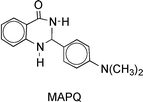We report organic electroluminescence (EL) devices based on a novel emissive molecule, 2-[4′-(N,N-dimethylaminophenyl)]-2,3-dihydroquinazolin-4(1H)-one (MAPQ). A three-layer structure consisting of MAPQ as emissive layer sandwiched between a hole transporting layer, N,N′-diphenyl-N,N′-bis(3-methylphenyl)-1,1-biphenyl-4,4′-diamine (TPD), and an electron transporting layer, tris(8-hydroxyquinolinato)aluminium (Alq3), ITO/TPD/MAPQ/Alq3/Al gave rise to a greenish-yellow peak located at around 538 nm, with coordinates (x = 0.447 and y = 0.510) in accordance with the Commission Internationale de L'Eclairage. An EL external quantum efficiency (ηext) of 0.07% at 125 A m2
and a brightness of 992 cd m−2 were observed, and the ηext is nearly constant or stable over a wide range of current densities (3–300 A m−2).
You have access to this article
 Please wait while we load your content...
Something went wrong. Try again?
Please wait while we load your content...
Something went wrong. Try again?


 Please wait while we load your content...
Please wait while we load your content...